KIA Optima 2014 3.G User Guide
Manufacturer: KIA, Model Year: 2014, Model line: Optima, Model: KIA Optima 2014 3.GPages: 479, PDF Size: 13.21 MB
Page 11 of 479
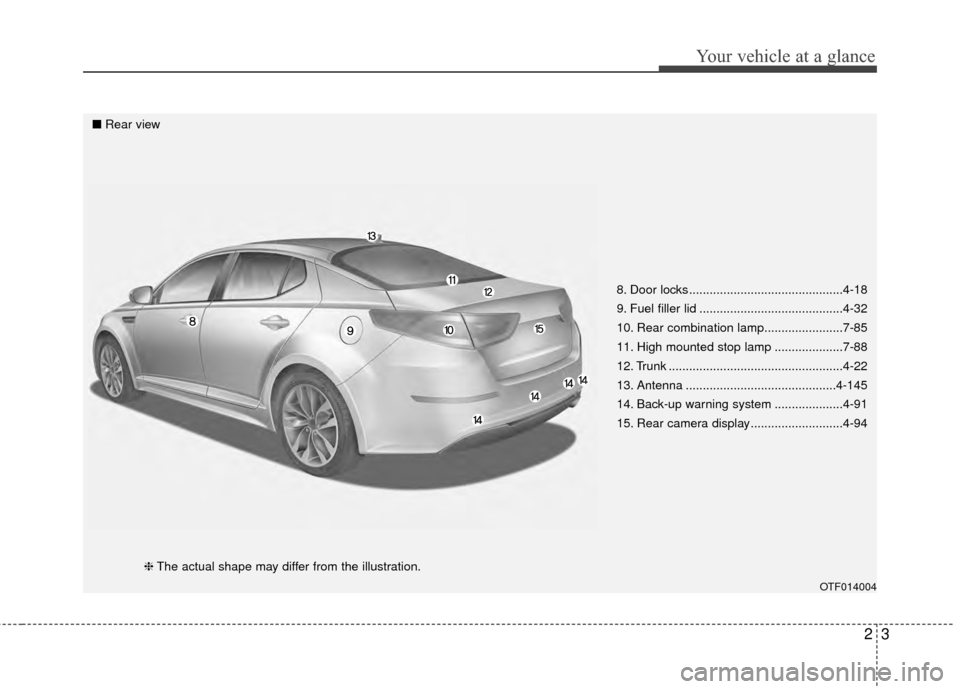
23
Your vehicle at a glance
8. Door locks .............................................4-18
9. Fuel filler lid ..........................................4-32
10. Rear combination lamp.......................7-85
11. High mounted stop lamp ....................7-88
12. Trunk ...................................................4-22
13. Antenna ............................................4-145
14. Back-up warning system ....................4-91
15. Rear camera display ...........................4-94
OTF014004
■Rear view
❈The actual shape may differ from the illustration.
Page 12 of 479
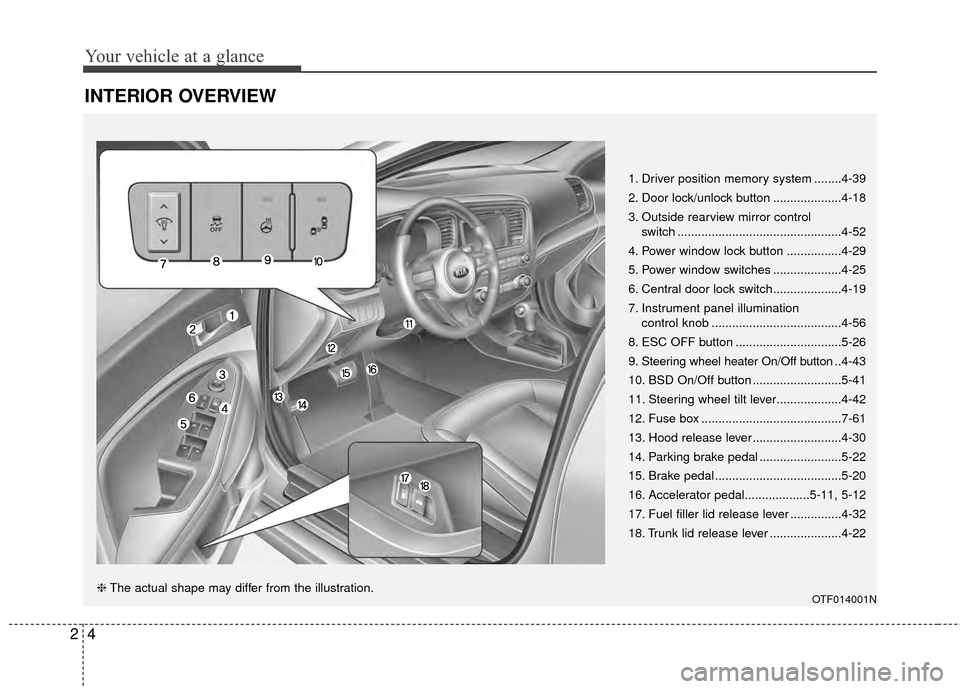
Your vehicle at a glance
42
INTERIOR OVERVIEW
1. Driver position memory system ........4-39
2. Door lock/unlock button ....................4-18
3. Outside rearview mirror control switch ................................................4-52
4. Power window lock button ................4-29
5. Power window switches ....................4-25
6. Central door lock switch....................4-19
7. Instrument panel illumination control knob ......................................4-56
8. ESC OFF button ...............................5-26
9. Steering wheel heater On/Off button .. 4-43
10. BSD On/Off button ..........................5-41
11. Steering wheel tilt lever...................4-42
12. Fuse box .........................................7-61
13. Hood release lever ..........................4-30
14. Parking brake pedal ........................5-22
15. Brake pedal .....................................5-20
16. Accelerator pedal...................5-11, 5-12
17. Fuel filler lid release lever ...............4-32
18. Trunk lid release lever .....................4-22
OTF014001N❈ The actual shape may differ from the illustration.
Page 13 of 479
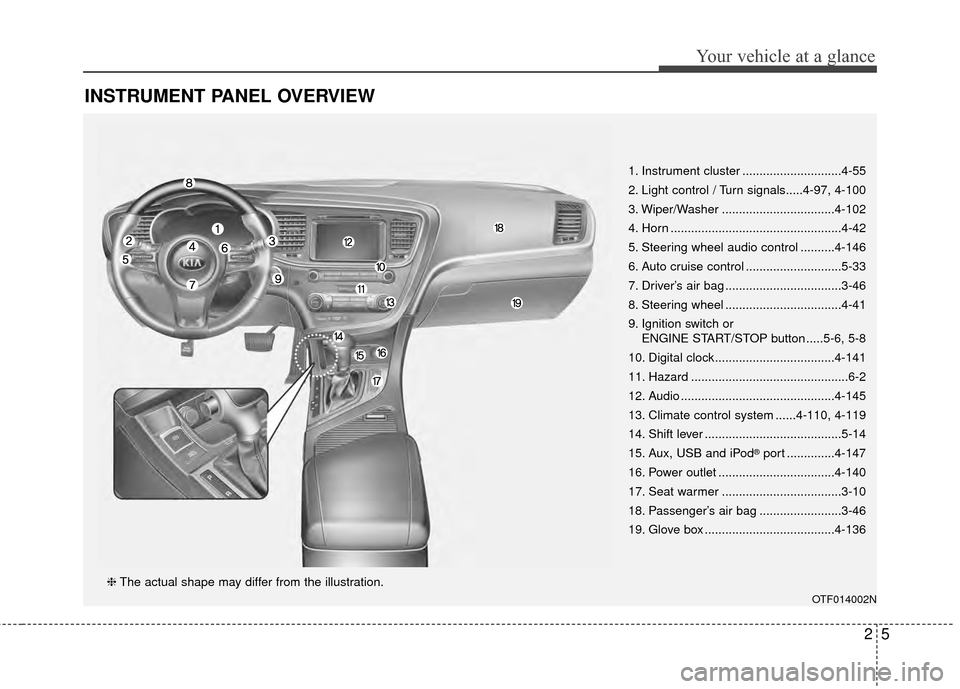
25
Your vehicle at a glance
INSTRUMENT PANEL OVERVIEW
1. Instrument cluster .............................4-55
2. Light control / Turn signals.....4-97, 4-100
3. Wiper/Washer .................................4-102
4. Horn ..................................................4-42
5. Steering wheel audio control ..........4-146
6. Auto cruise control ............................5-33
7. Driver’s air bag ..................................3-46
8. Steering wheel ..................................4-41
9. Ignition switch or ENGINE START/STOP button .....5-6, 5-8
10. Digital clock ...................................4-141
11. Hazard ..............................................6-2
12. Audio .............................................4-145
13. Climate control system ......4-110, 4-119
14. Shift lever ........................................5-14
15. Aux, USB and iPod
®port ..............4-147
16. Power outlet ..................................4-140
17. Seat warmer ...................................3-10
18. Passenger’s air bag ........................3-46
19. Glove box ......................................4-136
OTF014002N
❈ The actual shape may differ from the illustration.
Page 14 of 479

Your vehicle at a glance
62
ENGINE COMPARTMENT
1. Engine coolant reservoir ...................7-31
2. Engine oil filler cap ...........................7-29
3. Brake fluid reservoir ..........................7-34
4. Air cleaner.........................................7-37
5. Fuse box ...........................................7-61
6. Positive battery terminal ...................7-44
7. Negative battery terminal..................7-44
8. Windshield washer fluid reservoir .....7-35
9. Radiator cap .....................................7-32
10. Engine oil dipstick ...........................7-29
OTF074002N/OYF071200N
* The actual engine room in the vehicle may differ from the illustration.
■
■
2.4L Engine
■
■ 2.0L Engine
Page 15 of 479
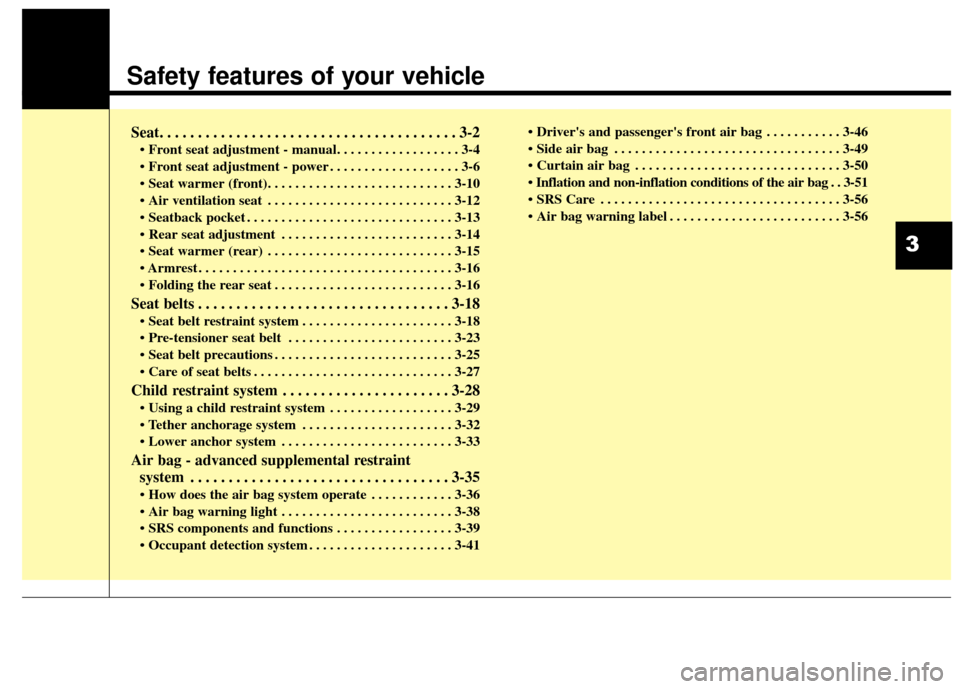
Safety features of your vehicle
Seat. . . . . . . . . . . . . . . . . . . . . . . . . . . . . . . . . . . . \
. . . 3-2
• Front seat adjustment - manual. . . . . . . . . . . . . . . . . . 3-4
. . . . . . . . . . . . . . . . . . . 3-6
. . . . . . . . . . . . . . . . . . . . . . . . . . . 3-12
. . . . . . . . . . . . . . . . . . . . . . . . . . . . . . 3-13
. . . . . . . . . . . . . . . . . . . . . . . . . 3-14
. . . . . . . . . . . . . . . . . . . . . . . . . . . 3-15
. . . . . . . . . . . . . . . . . . . . . . . . . . . . . . . . . . . . \
. 3-16
. . . . . . . . . . . . . . . . . . . . . . . . . . 3-16
Seat belts . . . . . . . . . . . . . . . . . . . . . . . . . . . . . . . . . 3-18
. . . . . . . . . . . . . . . . . . . . . . 3-18
. . . . . . . . . . . . . . . . . . . . . . . . 3-23
. . . . . . . . . . . . . . . . . . . . . . . . . . 3-25
. . . . . . . . . . . . . . . . . . . . . . . . . . . . . 3-27
Child restraint system . . . . . . . . . . . . . . . . . . . . . . 3-28
. . . . . . . . . . . . . . . . . . 3-29
. . . . . . . . . . . . . . . . . . . . . . 3-32
. . . . . . . . . . . . . . . . . . . . . . . . . 3-33
Air bag - advanced supplemental restraint system . . . . . . . . . . . . . . . . . . . . . . . . . . . . . . . . . . 3-35\
. . . . . . . . . . . . 3-36
. . . . . . . . . . . . . . . . . . . . . . . . . 3-38
. . . . . . . . . . . . . . . . . 3-39
. . . . . . . . . . . . . . . . . . . . . 3-41 . . . . . . . . . . . 3-46
. . . . . . . . . . . . . . . . . . . . . . . . . . . . . . . . . 3-49
. . . . . . . . . . . . . . . . . . . . . . . . . . . . . . 3-50
. . 3-51
. . . . . . . . . . . . . . . . . . . . . . . . . . . . . . . . . . . 3-\
56
. . . . . . . . . . . . . . . . . . . . . . . . . 3-56
3
Page 16 of 479
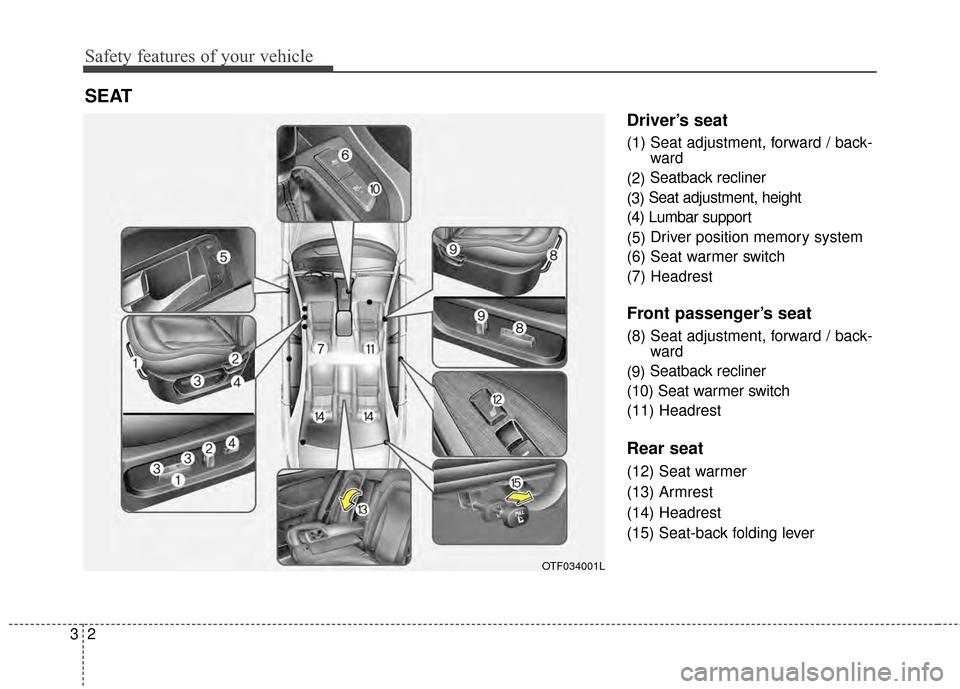
Safety features of your vehicle
23
Driver’s seat
(1) Seat adjustment, forward / back-ward
(2) Seatback recliner
(3) Seat adjustment, height
(4) Lumbar support
(5) Driver position memory system
(6) Seat warmer switch
(7) Headrest
Front passenger’s seat
(8) Seat adjustment, forward / back- ward
(9) Seatback recliner
(10) Seat warmer switch
(11) Headrest
Rear seat
(12) Seat warmer
(13) Armrest
(14) Headrest
(15) Seat-back folding lever
SEAT
OTF034001L
Page 17 of 479
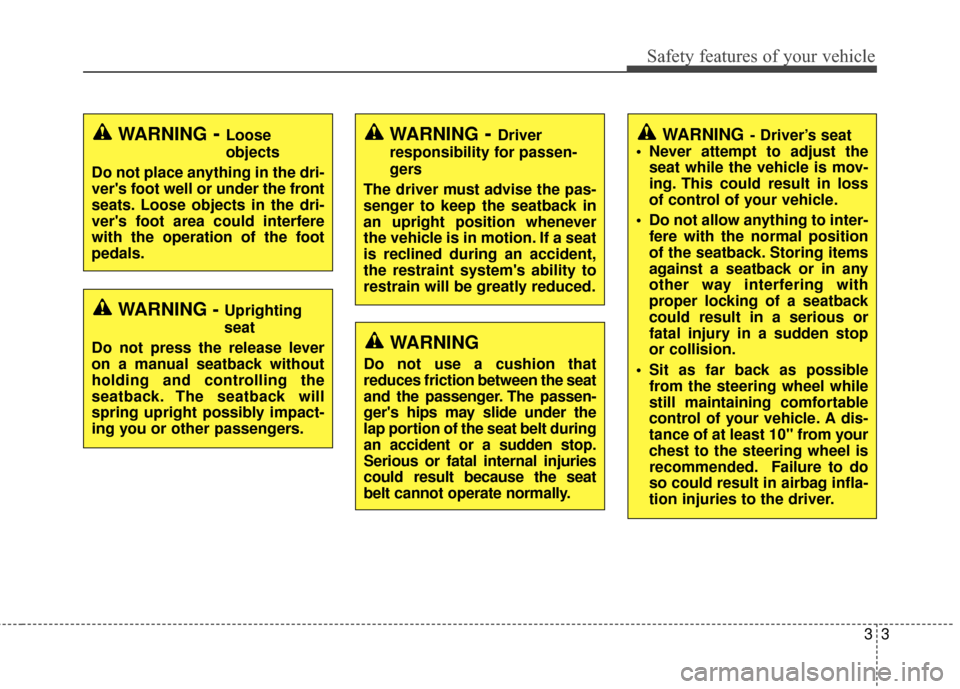
33
Safety features of your vehicle
WARNING- Driver’s seat
Never attempt to adjust the seat while the vehicle is mov-
ing. This could result in loss
of control of your vehicle.
Do not allow anything to inter- fere with the normal position
of the seatback. Storing items
against a seatback or in any
other way interfering with
proper locking of a seatback
could result in a serious or
fatal injury in a sudden stop
or collision.
Sit as far back as possible from the steering wheel while
still maintaining comfortable
control of your vehicle. A dis-
tance of at least 10" from your
chest to the steering wheel is
recommended. Failure to do
so could result in airbag infla-
tion injuries to the driver.
WARNING - Uprighting
seat
Do not press the release lever
on a manual seatback without
holding and controlling the
seatback. The seatback will
spring upright possibly impact-
ing you or other passengers.
WARNING- Loose
objects
Do not place anything in the dri-
ver's foot well or under the front
seats. Loose objects in the dri-
ver's foot area could interfere
with the operation of the foot
pedals.WARNING- Driver
responsibility for passen-
gers
The driver must advise the pas-
senger to keep the seatback in
an upright position whenever
the vehicle is in motion. If a seat
is reclined during an accident,
the restraint system's ability to
restrain will be greatly reduced.
WARNING
Do not use a cushion that
reduces friction between the seat
and the passenger. The passen-
ger's hips may slide under the
lap portion of the seat belt during
an accident or a sudden stop.
Serious or fatal internal injuries
could result because the seat
belt cannot operate normally.
Page 18 of 479
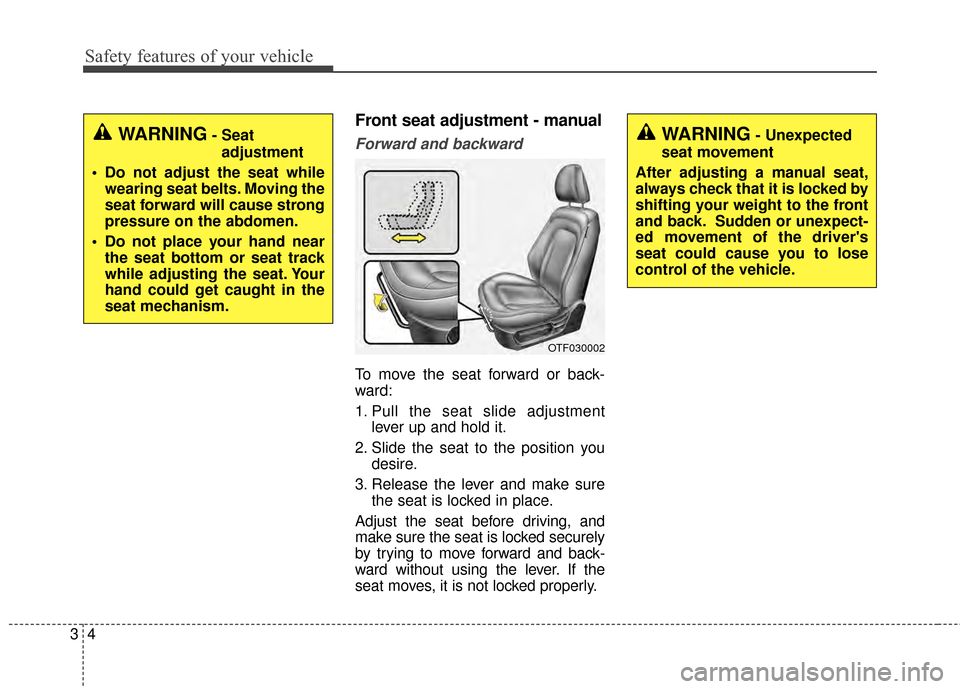
Safety features of your vehicle
43
Front seat adjustment - manual
Forward and backward
To move the seat forward or back-
ward:
1. Pull the seat slide adjustmentlever up and hold it.
2. Slide the seat to the position you desire.
3. Release the lever and make sure the seat is locked in place.
Adjust the seat before driving, and
make sure the seat is locked securely
by trying to move forward and back-
ward without using the lever. If the
seat moves, it is not locked properly.
WARNING- Seat adjustment
Do not adjust the seat while wearing seat belts. Moving the
seat forward will cause strong
pressure on the abdomen.
Do not place your hand near the seat bottom or seat track
while adjusting the seat. Your
hand could get caught in the
seat mechanism.WARNING- Unexpected
seat movement
After adjusting a manual seat,
always check that it is locked by
shifting your weight to the front
and back. Sudden or unexpect-
ed movement of the driver's
seat could cause you to lose
control of the vehicle.
OTF030002
Page 19 of 479
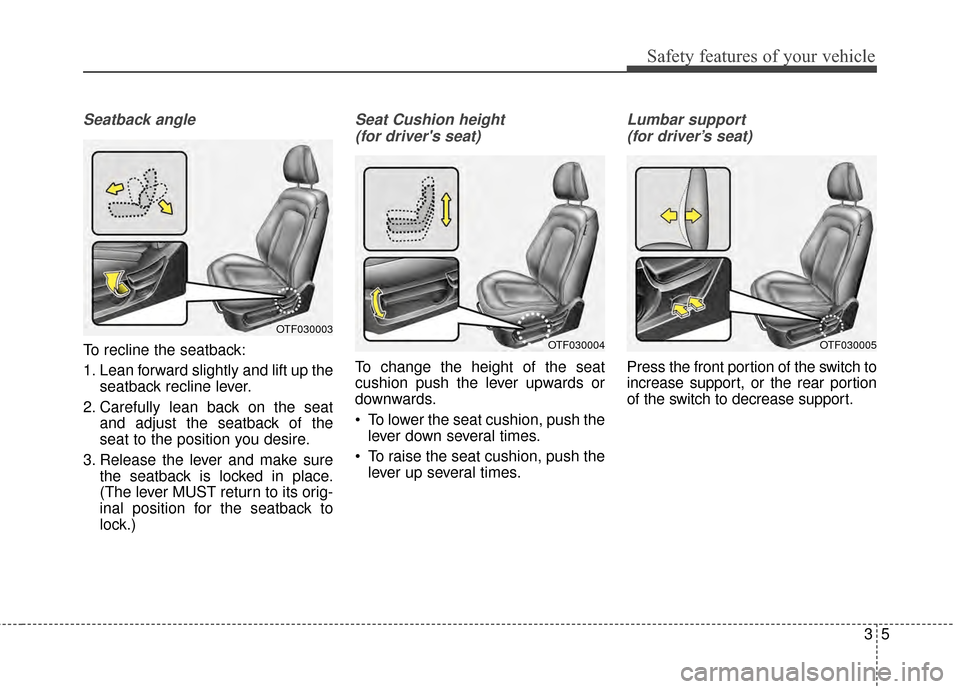
35
Safety features of your vehicle
Seatback angle
To recline the seatback:
1. Lean forward slightly and lift up theseatback recline lever.
2. Carefully lean back on the seat and adjust the seatback of the
seat to the position you desire.
3. Release the lever and make sure the seatback is locked in place.
(The lever MUST return to its orig-
inal position for the seatback to
lock.)
Seat Cushion height
(for driver's seat)
To change the height of the seat
cushion push the lever upwards or
downwards.
• To lower the seat cushion, push the lever down several times.
To raise the seat cushion, push the lever up several times.
Lumbar support
(for driver’s seat)
Press the front portion of the switch to
increase support, or the rear portion
of the switch to decrease support.
OTF030003
OTF030004OTF030005
Page 20 of 479
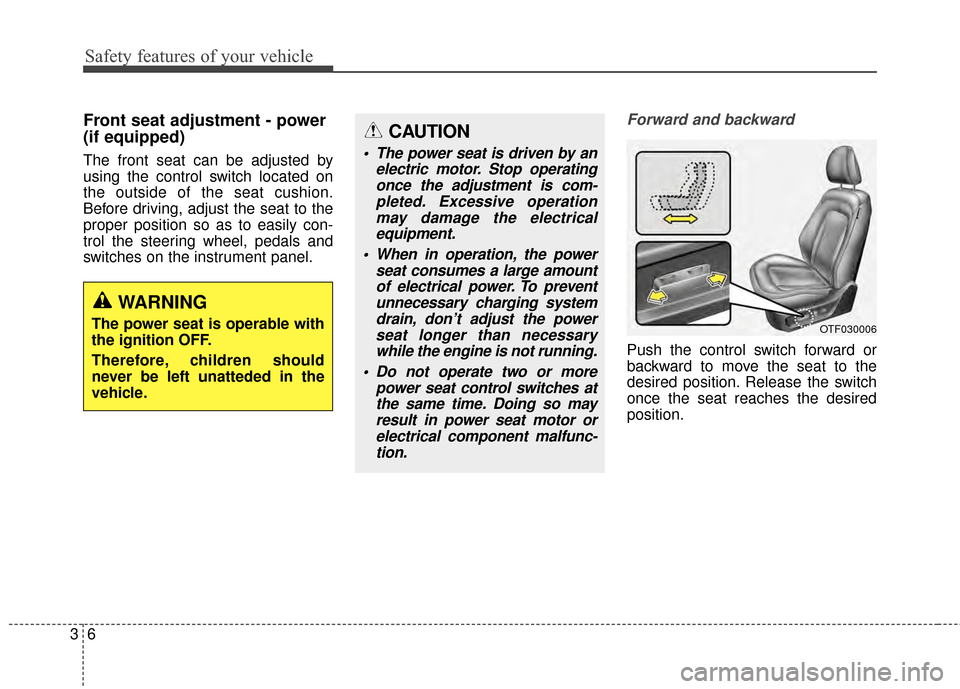
Safety features of your vehicle
63
Front seat adjustment - power
(if equipped)
The front seat can be adjusted by
using the control switch located on
the outside of the seat cushion.
Before driving, adjust the seat to the
proper position so as to easily con-
trol the steering wheel, pedals and
switches on the instrument panel.
Forward and backward
Push the control switch forward or
backward to move the seat to the
desired position. Release the switch
once the seat reaches the desired
position.
WARNING
The power seat is operable with
the ignition OFF.
Therefore, children should
never be left unatteded in the
vehicle.
CAUTION
The power seat is driven by anelectric motor. Stop operatingonce the adjustment is com-pleted. Excessive operationmay damage the electricalequipment.
When in operation, the power seat consumes a large amountof electrical power. To preventunnecessary charging systemdrain, don’t adjust the powerseat longer than necessarywhile the engine is not running.
Do not operate two or more power seat control switches atthe same time. Doing so mayresult in power seat motor orelectrical component malfunc-tion.
OTF030006